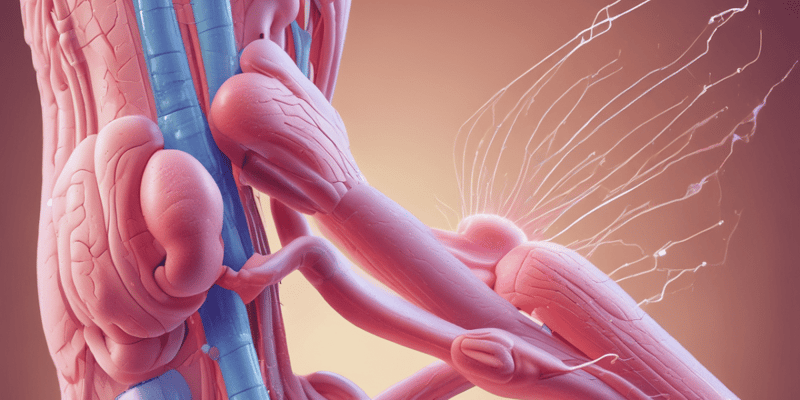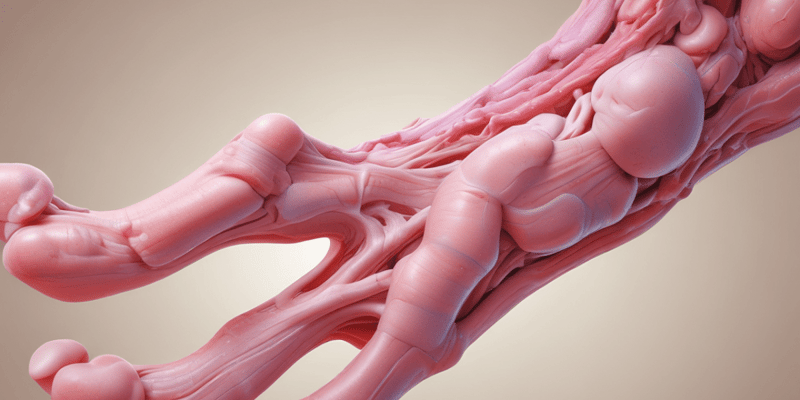Podcast
Questions and Answers
What is the PRIMARY objective of the lecture given by Assist.prof.HASSAN KHUDER RAJAB?
What is the PRIMARY objective of the lecture given by Assist.prof.HASSAN KHUDER RAJAB?
What is the MAIN non-pharmacological therapy recommended for patients with acute gouty arthritis?
What is the MAIN non-pharmacological therapy recommended for patients with acute gouty arthritis?
When is colchicine most effective in relieving acute gout attacks?
When is colchicine most effective in relieving acute gout attacks?
What is the MAIN adverse effect associated with oral colchicine use?
What is the MAIN adverse effect associated with oral colchicine use?
Signup and view all the answers
What is the MAIN contraindication for concurrent use of colchicine and macrolide antibiotics?
What is the MAIN contraindication for concurrent use of colchicine and macrolide antibiotics?
Signup and view all the answers
Which of the following is a NON-GI adverse effect associated with colchicine use?
Which of the following is a NON-GI adverse effect associated with colchicine use?
Signup and view all the answers
What is the recommended prophylactic treatment for patients with frequent attacks of gouty arthritis?
What is the recommended prophylactic treatment for patients with frequent attacks of gouty arthritis?
Signup and view all the answers
What is the recommended dose adjustment for colchicine in patients with renal or hepatic dysfunction?
What is the recommended dose adjustment for colchicine in patients with renal or hepatic dysfunction?
Signup and view all the answers
When should uricosuric drugs such as probenecid and sulfinpyrazone be used?
When should uricosuric drugs such as probenecid and sulfinpyrazone be used?
Signup and view all the answers
What is the recommended approach to discontinuing prophylactic treatment for gout?
What is the recommended approach to discontinuing prophylactic treatment for gout?
Signup and view all the answers
What is the recommended approach to treating an acute attack of gouty arthritis in a patient receiving prophylactic colchicine?
What is the recommended approach to treating an acute attack of gouty arthritis in a patient receiving prophylactic colchicine?
Signup and view all the answers
What is the recommended approach to starting uricosuric drug therapy for gout?
What is the recommended approach to starting uricosuric drug therapy for gout?
Signup and view all the answers
What is the recommended initial daily dose of probenecid?
What is the recommended initial daily dose of probenecid?
Signup and view all the answers
How often should the daily dose of sulfinpyrazone be increased during therapy?
How often should the daily dose of sulfinpyrazone be increased during therapy?
Signup and view all the answers
What is the maximum recommended daily dose of probenecid?
What is the maximum recommended daily dose of probenecid?
Signup and view all the answers
What are the major side effects associated with uricosuric therapy?
What are the major side effects associated with uricosuric therapy?
Signup and view all the answers
In which patients are probenecid and sulfinpyrazone contraindicated?
In which patients are probenecid and sulfinpyrazone contraindicated?
Signup and view all the answers
Which statement about colchicine dosing for acute gout attacks is correct?
Which statement about colchicine dosing for acute gout attacks is correct?
Signup and view all the answers
Which statement regarding the use of IV colchicine is true?
Which statement regarding the use of IV colchicine is true?
Signup and view all the answers
What is the recommended initial IV dose of colchicine, if considered necessary?
What is the recommended initial IV dose of colchicine, if considered necessary?
Signup and view all the answers
If a patient receives a full IV course of colchicine, how long should they wait before receiving colchicine by any route?
If a patient receives a full IV course of colchicine, how long should they wait before receiving colchicine by any route?
Signup and view all the answers
Which statement about the use of corticosteroids in acute gout attacks is correct?
Which statement about the use of corticosteroids in acute gout attacks is correct?
Signup and view all the answers
What is the recommended dose and duration of corticosteroid therapy for acute gout attacks?
What is the recommended dose and duration of corticosteroid therapy for acute gout attacks?
Signup and view all the answers
What is the recommended duration for gradually tapering the dose of steroids during withdrawal?
What is the recommended duration for gradually tapering the dose of steroids during withdrawal?
Signup and view all the answers
Which of the following is a recommended alternative to oral steroid therapy if patients are unable to take oral medication?
Which of the following is a recommended alternative to oral steroid therapy if patients are unable to take oral medication?
Signup and view all the answers
What is the recommended dosage range for ACTH gel administration?
What is the recommended dosage range for ACTH gel administration?
Signup and view all the answers
When can prophylactic treatment for gout be withheld, according to the text?
When can prophylactic treatment for gout be withheld, according to the text?
Signup and view all the answers
Which of the following is recommended as adjunctive therapy to injectable corticosteroids to prevent rebound flare-ups?
Which of the following is recommended as adjunctive therapy to injectable corticosteroids to prevent rebound flare-ups?
Signup and view all the answers
What is the recommended dosage range for intraarticular administration of triamcinolone hexacetonide for acute gout limited to one or two joints?
What is the recommended dosage range for intraarticular administration of triamcinolone hexacetonide for acute gout limited to one or two joints?
Signup and view all the answers




